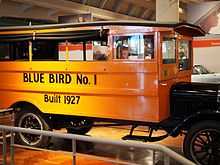Albert Luce
Albert L. Luce (died 1962)[1] was an American industrialist, entrepreneur, bus designer, and business owner. He is best known for founding the Blue Bird Body Company, a bus and recreational vehicle manufacturer now known as Blue Bird Corporation which is now one of three major large (full-sized) school bus manufacturers in North America.
Biography

Albert L. Luce was a Ford Motor Company franchised dealer in Fort Valley and Perry, Georgia. In response to a request from one of his customers, in 1927 Luce and his dealership designed and built a bus body with structural enhancements over those generally on the market at that time, notably angle iron roof bows and all-metal construction (except for a canvas roof). At the time, most school bus bodies built in North America contained a lot of woodwork in their construction, and the advantages of steel were still being explored by various manufacturers.
He founded the bus manufacturing company, later joined by his sons, George Luce, Albert L. Luce Jr, and Joseph P Luce. At the time, there was a trend in education away from one-room schools to larger consolidated schools which required transportation of pupils greater distances than in the past. The Great Depression was negatively impacting car and truck sales at his Ford dealerships, so he sold them to concentrate on bus manufacturing. The Blue Bird trade name was adopted from the color of a demonstrator bus in 1932.
Luce's company joined other small and large manufacturers in the industry in primarily building bodies for installation upon cowl-type truck chassis built by large companies such as International Harvester, General Motors, and Ford. These units are called "conventional" (or type "C") models in industry terminology, and have front end sheet metal such as hoods and fenders made by the truck companies. Visibility of children crossing in front of these models has always been a concern for those operating school buses.
After World War II, Albert L Luce led his business in a new direction by purchasing a different type of chassis he saw at a show in Paris, France, one which would accommodate a virtually vertical ("flat") front end. Returning to Georgia, he put his engineers to work, and in 1952, introduced the Blue Bird All American, generally considered the first successful "transit-style" school bus to be mass-produced for school districts and contractors. This design is now known as type "D" within the industry.
Luce further diversified his products by offering small transit buses, and using All-American engineering to produce the Wanderlodge, a premium motor home.
Although the younger generation of the Luce family had taken over leadership by the 1970s, the school bus manufacturing industry saw a consolidation in the 1980s, and six major full-size school bus manufacturers saw their ranks reduced to only three, as Superior Coach Company, Wayne Corporation, and Carpenter Body Works became fallen flags.
In the 1990s, the Luce family retired from the bus and recreational vehicle business, and sold their interest to investors. The company currently is considered in third place volume-wise among the surviving manufacturers.
Pioneers of the yellow school bus industry
Mr. Luce is among the early school bus industry pioneers including Perley A. Thomas, who founded Thomas Built Buses, "Dave" Ward, founder of Ward Body Works (now IC Bus), and the educator Dr. Frank W. Cyr, who, for his persistent work since 1939 to develop school bus safety standards across the country, is widely considered the father of the yellow school bus.
References
- ↑ "Blue Bird enjoys a rich heritage in the transportation industry. Take a moment to review the timeline below to see just some of the milestones that went into the evolution of this over 80-year-old company.". About us. Blue Bird Corporation. Retrieved 10 April 2011.